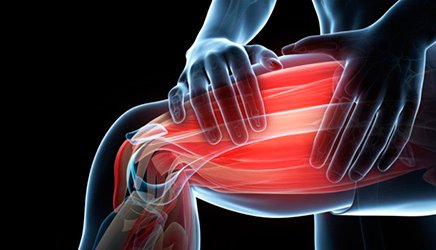
The benefits of exercise are enormous. Heart health, brain function, mood, weight loss, and bone structure, among other things, can all be improved with proper exercise. However, like most things, there can be some uncomfortable side effects from exercise. One of the most common, especially for people who are new or returning to an exercise routine after some time off, is known as delayed onset muscle soreness.
Delayed onset muscle soreness, or DOMS, is the stiffness, discomfort, pain, and sometimes cramping of the muscles which typically begins to develop 12-24 hours after the exercise has been performed. Symptoms of DOMS usually peak between 24-72 hours after exercise. Understanding what causes DOMS and how to treat the symptoms or even prevent it from happening in the first place will make your exercise experience more effective and enjoyable.
Concentric vs. Eccentric Muscle Contraction
During resistance exercise, there are two main types of muscle contractions, concentric and eccentric contractions. The easiest example to represent this is a bicep curl. The concentric contractions occur when the weight is being lifted up, and the muscle gets shorter. Eccentric contractions occur during the lowering phase of the exercise, while the bicep is being lengthened under tension. It is widely accepted that this eccentric phase leads to tiny microscopic tears in the muscle tissue itself. The pain and discomfort from these muscle tears often takes awhile to become symptomatic, hence the term “delayed onset.” Other symptoms of DOMS include tenderness to the touch, limited range of joint motion, temporary reduction of strength, and swelling of the affected limbs.
Preventing and Reducing the Effects of Delayed Onset Muscle Soreness (DOMS)
Preventing DOMS completely is tricky, but there are ways to reduce the severity of symptoms. One of the best ways to do this is to progress slowly into any new exercise program or routine, allowing your muscles to adapt to new movements and loads. There is little evidence showing that warm-up exercises such as stretching will improve symptoms of DOMS, however if the stretching is done properly it can help maintain health of muscles and prevent future injury. There are different trains of thought when it comes to stretching, but in my opinion dynamic, active stretches should be done prior to exercise, while static hold stretching is best if saved until after the exercise has been completed.
Fueling your body with proper nutrients can also help reduce the severity of DOMS. The two key aspects of focus should be reducing inflammation and feeding the muscle tissue what it needs to repair itself from those micro tears. Some great anti-inflammatory foods include turmeric, berries, ginger, and fatty fish, and should be fundamental foods in any healthy diet. Post-workout whey protein shakes have become a staple in the fitness industry, as these provide the essential amino acids needed to repair damaged muscle tissue and help the muscles grow. However, this industry is flooded with poor quality supplements. To pick a good brand, check the label. Whey products are best if sourced from grass-fed animals. Also, make sure to avoid products that use any artificial sweeteners, such as sucralose. There are good brands out there that use stevia or other natural sweeteners to improve flavor. While whey protein is the most common source used for post-workout recovery, not everyone responds well to whey. Other alternatives include bone broth, pea, and rice protein.
Delayed onset muscle soreness is an annoying side effect of healthy exercise, but is usually not serious and will resolve in a few days. With the right techniques, it is possible to exercise effectively without suffering too much. Ask how we can help!
Yours in Health, Dr. Alex
